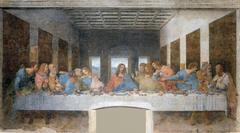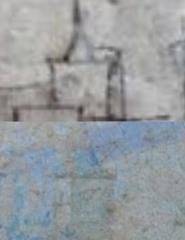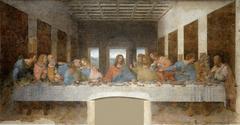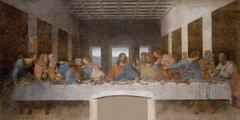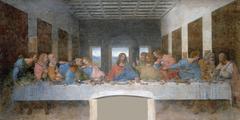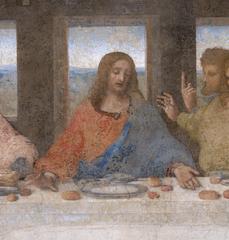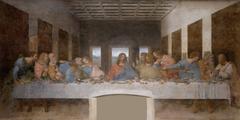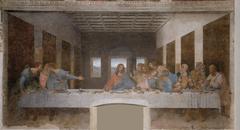
The Last Supper Milan: Visiting Hours, Tickets, and Historical Significance
Date: 14/06/2025
Introduction
Leonardo da Vinci’s The Last Supper is one of the world’s most celebrated masterpieces, attracting millions of visitors to Milan each year. Created between 1495 and 1498 on the wall of the Convent of Santa Maria delle Grazie, this mural not only epitomizes Renaissance artistry but also stands as a symbol of the city’s religious, political, and cultural legacy. Today, visiting The Last Supper is a carefully managed experience, requiring advance booking, strict adherence to visiting hours, and respect for conservation efforts (arttern.com; everysteph.com; cenacolovinciano.org).
This comprehensive guide provides detailed information on the mural’s history, visiting hours, ticketing, accessibility, visitor tips, and nearby attractions—helping you plan a memorable and respectful visit to one of Milan’s most iconic historical sites.
Table of Contents
- Origins and Commissioning of The Last Supper
- Leonardo da Vinci’s Artistic Approach and Technique
- The Biblical Narrative and Symbolism
- Deterioration, Damage, and Restoration
- Visiting The Last Supper: Hours, Tickets, and Tips
- Nearby Attractions and Travel Advice
- Cultural and Artistic Legacy
- The Setting: Santa Maria delle Grazie
- Frequently Asked Questions (FAQ)
- Visitor Experience: What to Expect
- Practical Tips for a Smooth Visit
- Visuals and Media Suggestions
- Related Articles
- Conclusion
- References and Further Reading
Origins and Commissioning of The Last Supper
The Last Supper was commissioned in 1494 by Ludovico Sforza, Duke of Milan, as a centerpiece for the refectory of the Convent of Santa Maria delle Grazie. This commission was both a religious offering and a political statement, intended to assert the Sforza family’s legacy and Milan’s prominence (arttern.com; worldhistoryedu.com). The church and convent, designed by Guiniforte Solari and later expanded by Donato Bramante, became a significant spiritual and cultural hub, now recognized as a UNESCO World Heritage Site (whc.unesco.org; santa-maria-delle-grazie.com).
Leonardo da Vinci’s Artistic Approach and Technique
Leonardo’s approach was revolutionary. Instead of traditional fresco painting on wet plaster, he used tempera and oil on dry plaster, allowing for more intricate detail but causing rapid deterioration (worldhistoryedu.com; milan-museum.com). His anatomical studies and use of live models enabled him to capture the apostles’ varied emotions, while his meticulous application of linear perspective focuses the viewer’s attention on Christ at the center (arttern.com).
The Biblical Narrative and Symbolism
The mural portrays the dramatic moment when Jesus announces his imminent betrayal, with apostles reacting in shock, disbelief, and sorrow. Leonardo arranged the apostles in dynamic groups of three—symbolizing the Holy Trinity—while Christ’s outstretched arms and the framing window behind him reinforce his spiritual centrality (santa-maria-delle-grazie.com; en.wikipedia.org).
Deterioration, Damage, and Restoration
Leonardo’s experimental technique, combined with environmental factors, led to the mural’s early deterioration. Damage from humidity, pollution, and World War II bombings threatened its survival, but extensive restoration campaigns—culminating in a major effort completed in 1999—have stabilized the artwork and preserved much of its original impact (worldhistoryedu.com; felizeyeartgallery.com).
Visiting The Last Supper: Hours, Tickets, and Tips
Opening Hours
The Last Supper is open Tuesday to Sunday, typically from 8:15 AM to 7:00 PM (last entry at 6:45 PM). The site is closed on Mondays and select holidays. Always verify current hours before visiting (cenacolovinciano.org).
Tickets and Booking
Due to conservation measures and high demand, tickets must be booked well in advance—often three months ahead (Italy On Foot; Untold Italy; lastsupperticket.com).
- Official tickets: €15.00 per adult, with discounts for EU citizens aged 18–25 (€2), and free entry for under-18s (booking required for all) (Untold Italy).
- Free entry: Available on the first Sunday of each month, but extremely limited and must be booked in advance (Untold Italy).
- Where to book: The official site is cenacolovinciano.org. If sold out, reputable resellers and guided tour providers such as GetYourGuide, Tiqets, and Viator are alternatives (European Traveler).
Entry Procedures
- Arrival: Arrive at least 15–30 minutes ahead of your slot to exchange your voucher for a ticket and pass security (European Traveler).
- Group size/time: Visits are strictly limited to groups of 25–40 people, with just 15 minutes inside the refectory (Cenacolo.it).
- Security: Only small bags allowed; lockers are provided for larger items (European Traveler).
- Dress code: Modest attire is required (shoulders and knees covered), which respects the still-active Dominican convent (Milan Last Supper Tickets; The Better Vacation).
Accessibility
The Last Supper is accessible to visitors with mobility impairments. Notify staff in advance for assistance; ramps and facilities are available (cenacolovinciano.org).
Guided Tours
Guided tours and audio guides are available in multiple languages. These provide richer context on the mural’s history, symbolism, and restoration (everysteph.com).
Nearby Attractions and Travel Advice
Combine your visit with other Milan historical sites such as the Milan Cathedral (Duomo di Milano), Sforza Castle, and Brera Art Gallery. The site is located at Piazza di Santa Maria delle Grazie, easily reached by metro (Conciliazione or Cadorna), tram, or on foot from the city center (Italy On Foot; Italy Things To Do).
Cultural and Artistic Legacy
The Last Supper has profoundly influenced Western art, from Renaissance masters to modern movements and pop culture. Its composition, perspective, and psychological depth inspired artists such as Raphael and Michelangelo, and continue to fuel scholarly debate and reinterpretation (psychologycharts.com). The mural’s spiritual and cultural resonance also makes it a focal point for Christian commemoration and global tourism.
The Setting: Santa Maria delle Grazie
The Convent of Santa Maria delle Grazie, a blend of Gothic and Renaissance architecture, provides a fitting context for the mural. The church’s tribune and cloisters, designed by Donato Bramante, further enrich the visitor experience (italia.it; whc.unesco.org).
Frequently Asked Questions (FAQ)
Q: How do I book tickets to The Last Supper?
A: Book online through cenacolovinciano.org or reputable tour providers. Tickets are released three months in advance and sell out quickly.
Q: What are the visiting hours?
A: Usually 8:15 AM–7:00 PM, Tuesday–Sunday. Always check for updates.
Q: Is photography allowed?
A: As of 2025, non-flash photography is generally permitted. Flash, tripods, and selfie sticks are not allowed (European Traveler).
Q: Is the site accessible?
A: Yes, with ramps and assistance for visitors with reduced mobility.
Q: How long is the visit?
A: Each group has 15 minutes inside the refectory.
Visitor Experience: What to Expect
Arrival and Entry
Upon arrival, present your printed voucher and ID at the ticket office. After security screening and storage of large bags, join a group for entry. You’ll pass through climate-controlled antechambers, which help preserve the mural, before entering the refectory (European Traveler). Modest dress and respectful conduct are required.
Viewing the Mural
Inside the refectory, you’ll have 15 minutes to view the 8.8 by 4.6-meter mural. Guided tours or audio guides can enrich your understanding of its artistic and historical context. Silence is encouraged to maintain a reverent atmosphere (The Better Vacation).
Practical Tips for a Smooth Visit
- Book early: Secure tickets as soon as they are released.
- Plan your schedule: Arrange your Milan itinerary around your visit slot.
- Arrive early: Allow time for ticket exchange and security.
- Dress appropriately: Shoulders and knees must be covered.
- Travel light: Only small bags are permitted.
- Consider a guided tour: For deeper insights into the mural and Milan’s history.
Visuals and Media Suggestions
- Use high-quality images of The Last Supper mural with alt text: “Leonardo da Vinci’s The Last Supper mural in Milan, Italy.”
- Include a map of Santa Maria delle Grazie’s location with descriptive alt text.
- Embed a virtual tour or video walkthrough of the museum for an enhanced experience.
Related Articles
Conclusion
Witnessing Leonardo da Vinci’s The Last Supper is a unique, deeply moving experience that connects visitors with the heights of Renaissance creativity and the enduring legacy of Milan’s historical sites. Careful planning—booking tickets well in advance, respecting scheduled visiting hours, and following site rules—ensures both a rewarding visit and the preservation of this irreplaceable masterpiece for generations to come.
For ticketing updates, travel tips, and exclusive content, download the Audiala app and explore our resources on Milan’s art and cultural heritage.
References and Further Reading
- arttern.com
- everysteph.com
- lastsupperticket.com
- milanlastsuppertickets.com
- whc.unesco.org
- cenacolovinciano.org
- italyonfoot.com
- worldhistoryedu.com
- santa-maria-delle-grazie.com
- milan-museum.com
- felizeyeartgallery.com
- psychologycharts.com
- Italy Things To Do
- The Better Vacation
- European Traveler
- GetYourGuide
- Tiqets
- Viator



